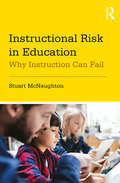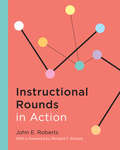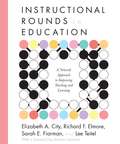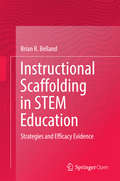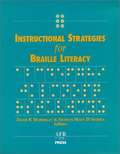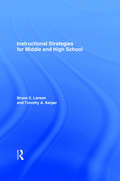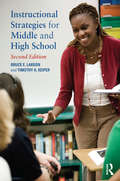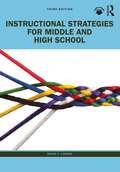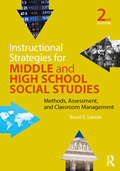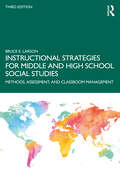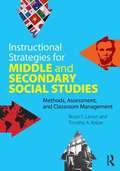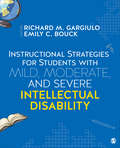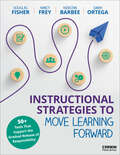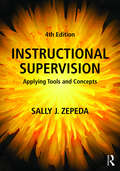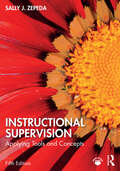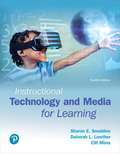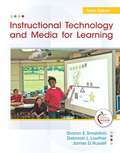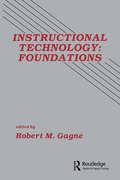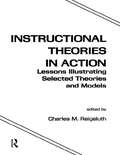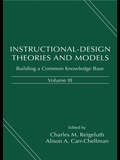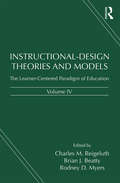- Table View
- List View
Instructional Risk in Education: Why Instruction Can Fail
by Stuart McNaughtonThis book is based on the idea that instruction carries in-built risks, and instructional practices can be counterproductive unless used with care. Referencing a wide range of approaches to increasing effectiveness, Instructional Risk provides an explanation of why some forms of instruction are less powerful than they should be. Elaborating on rather than advising against these forms of instruction, it illustrates how teachers can use instructional practices effectively through managing risk and being adaptive in their use of them in the many and dynamic microsystems of the classroom. The book is unique in bringing together disparate evidence from a range of research areas and across core curriculum areas of English Language Arts, mathematics and science, for a theory of ‘Instructional Risk’; the basic proposition for which is that instructional approaches carry known and predictable risks. The book focuses on the expertise required to overcome risks, which are exaggerated for children from communities not well served by our schools. The book is also a critique of research that is 'programmatic' and limited to experimental evidence and summaries of that evidence which are uncritically developed into statements about ‘What Works’. Made to be both an explication of the theory through repeated examples as well as a technical resource, this book will be vital reading for lecturers and postgraduate students of Education and Educational Psychology.
Instructional Rounds in Action
by Richard E. Elmore John E. RobertsInstructional Rounds in Action is an invaluable guide for those involved in implementing instructional rounds as the foundation and framework for systemic improvement in schools. Over the past few years, districts across the United States, Canada, and Australia have begun implementing "instructional rounds," a set of ideas and practices for advancing systemic, district-wide improvement. But as they do so, practical and theoretical questions arise. <P><P>Roberts offers a powerful analysis of how instructional rounds can work "on the ground." His book weaves together the voices of stakeholders at all levels--teachers, principals, and district personnel--and presents a number of protocols to support instructional rounds.
Instructional Rounds in Action: NULL
by John E. RobertsInstructional Rounds in Action is an invaluable guide for those involved in implementing instructional rounds as the foundation and framework for systemic improvement in schools. Over the past few years, districts across the United States, Canada, and Australia have begun implementing &“instructional rounds,&” a set of ideas and practices for advancing systemic, district-wide improvement. But as they do so, practical and theoretical questions arise. Roberts offers a powerful analysis of how instructional rounds can work &“on the ground.&” His book weaves together the voices of stakeholders at all levels—teachers, principals, and district personnel—and presents a number of protocols to support instructional rounds.
Instructional Rounds in Education: A Network Approach to Improving Teaching and Learning
by Elizabeth A. City; Richard F. Elmore; Sarah.E. Fiarman; Lee TietelWalk into any school in America and you will see adults who care deeply about their students and are doing the best they can every day to help students learn. But you will also see a high degree of variability among classrooms—much higher than in most other industrialised countries.
Instructional Scaffolding in STEM Education
by Brian R. BellandThis book uses meta-analysis to synthesize research on scaffolding and scaffolding-related interventions in STEM (science, technology, engineering, and mathematics) education. Specifically, the volume examines the extent to which study quality, assessment type, and scaffolding characteristics (strategy, intended outcome, fading schedule, scaffolding intervention, and paired intervention) influence cognitive student outcomes. It includes detailed descriptions of the theoretical foundations of scaffolding, scaffolding strategies that have been proposed to meet different intended learning outcomes in STEM, and associated efficacy information. Furthermore, the book describes assessment strategies and study designs which can be used to evaluate the influence of scaffolding, and suggests new fields in which scaffolding strategies that have proven efficacious may be used.
Instructional Strategies for Braille Literacy
by Diane P. Wormsley Frances M. D'AndreaOffers instructors specific, practical strategies for the teaching of Braille reading and writing. Chapters discuss general guidelines and strategies; fostering emergent learning; making the transition from print to Brail teaching Braille to students with special needs, and to students who speak English as a second langua assessing the literary skills of students who are blind or visually impaired; and technology and Braille. Annotation copyrighted by Book News, Inc. , Portland, OR
Instructional Strategies for Middle and High School
by Bruce E. Larson Timothy A. KeiperInstructional Strategies for Middle and High School is an accessible, practical, and engaging methods textbook that introduces pre-service teachers to various instructional strategies and helps them to decide how and when to use these methods in the classroom. Classrooms are comprised of diverse learners, and aspiring teachers will face complex decisions about the assessment of student learning and classroom management. Instructional Strategies for Middle and High School equips pre-service teachers with the methodological tools to promote understanding, conceptual awareness, and learning for every child in the classroom. Features include: clear, step-by-step descriptions of seven instructional techniques that pre-service teachers can realistically implement within the classroom setting practical suggestions for ways to integrate effective classroom management and valid assessment techniques with each instructional strategy concrete examples to illustrate each concept or teaching method described guidelines for deciding which instructional methods are most appropriate to different classroom situations and for diverse learners guides for creating lesson plans access to a comprehensive companion website that provides additional resources and further ways to engage with the material presented in the chapters. http://www.routledge.com/textbooks/instructionalstrategies
Instructional Strategies for Middle and High School
by Bruce E. Larson Timothy A. KeiperInstructional Strategies for Middle and High School is an accessible, practical, and engaging methods textbook that introduces pre-service teachers to various instructional strategies and helps them to decide how and when to use these methods in the classroom. Classrooms are comprised of diverse learners, and aspiring teachers will face complex decisions about the assessment of student learning and classroom management. Veteran teacher educators Bruce Larson and Timothy Keiper offer practical suggestions for ways to integrate effective classroom management and valid assessment techniques with each instructional strategy. Instructional Strategies for Middle and High School equips pre-service teachers with the methodological tools to promote understanding, conceptual awareness, and learning for every child in the classroom. Features and updates to this new edition include: Clear, step-by-step descriptions and illustrative in-class videos of seven instructional techniques and that pre-service teachers can realistically implement within the classroom setting Increased coverage on teaching English language learners, including a "Making Your Lesson More Meaningful for ELLs" feature now included in every instructional strategy chapter "Enhancing Your Teaching With Technology" feature included in every instructional strategy chapter Fresh interior design to better highlight pedagogical elements and key features, all to better engage students Fully revamped and comprehensive companion website, with both student and instructor materials that stress real-world application of strategies, classroom assessment and management.
Instructional Strategies for Middle and High School
by Bruce E. LarsonInstructional Strategies for Middle and High School is an accessible, practical, and engaging methods textbook that introduces pre-service teachers to various instructional strategies and helps them to decide how and when to use these methods in the classroom. Classrooms are comprised of diverse learners, and aspiring teachers will face complex decisions about student assessment. This book offers practical suggestions for ways to integrate effective classroom management and valid assessment techniques with each instructional strategy. Key features include: Clear, step-by-step descriptions of six instructional techniques that pre-service teachers can realistically implement within the classroom setting and videos of these strategies being employed in actual middle-school classrooms; Practical suggestions for ways to integrate effective classroom management and valid assessment techniques with each instructional strategy; Concrete examples to illustrate each concept or teaching method described; Guidelines for deciding which instructional methods are most appropriate to different classroom situations and for diverse learners, including "Teaching with Technology" and "Teaching English Language Learners" features now included in every chapter. This book equips pre-service teachers with the methodological tools to promote understanding, conceptual awareness, and learning for every student. Updated and fully comprehensive online support materials, with both student and instructor resources, offer real-world applications of strategies, classroom assessment and management. Resources include videos, lesson templates, review questions, state standard assessments, and more.
Instructional Strategies for Middle and High School Social Studies: Methods, Assessment, and Classroom Management
by Bruce E. LarsonInstructional Strategies for Middle and High School Social Studies: Methods, Assessment, and Classroom Management is an exciting methods-based text that integrates appropriate management and assessment techniques with seven distinct teaching strategies. Writing explicitly for pre-service social studies teachers, veteran teacher educator Bruce E. Larson offers detailed descriptions of a range of instructional strategies, along with guidelines for deciding how and when to use each. Part I offers the foundations for teaching and learning in a social studies classroom, and explores contextual, theoretical, and policy factors that all teachers need to consider before entering the classroom. Part II delivers a range of comprehensive strategies for providing instruction that is appropriate for particular lessons, student abilities, and classroom environments. The practical strategies in Part II build upon the learning theories described in Part I, positioning Instructional Strategies for Middle and High School Social Studies to be the go-to, all-inclusive teacher's guide to the social studies classroom. New to this Edition A list of goals before each chapter presents an overview of the chapter's content focus, and provides an outline for the chapter review. Extensively revised Part I (chapters 1-4) provides an updated review of national standards developed for teaching history, geography, civics, and economics. In-depth applications of the Common Core State Standards for the social studies are also explored. New "Reality Check" feature provides directions for integrating field-based experiences into the chapters, and contextualizes the ideas in the book for a classroom setting. Each chapter in Part II (chapters 5-11) has been expanded to include a section labeled "Enhancing Student Learning with Technology," offering websites, links, and other resources for integrating recent technologies into the classroom. Chapters 5-11 include a new "Making Your Lesson More Meaningful for ELLs" feature, which provides ideas--based on current research and theories about learning language--for engaging ELLs, specific for each instructional strategy. Expanded discussion of the "Understanding by Design" model equips teachers to design learning experiences that promote student understanding by intentionally designing what happens in the classroom, and developing authentic formative assessments of student learning.
Instructional Strategies for Middle and High School Social Studies: Methods, Assessment, and Classroom Management
by Bruce E. LarsonInstructional Strategies for Middle and High School Social Studies: Methods, Assessment, and Classroom Management is an exciting methods-based text that integrates appropriate management and assessment techniques with seven distinct teaching strategies for pre-service social studies teachers. This fully updated text includes new topics and assessment examples, expanded discussions of the teaching methods, and guidance on differentiating lessons for multiple learning levels. Part 1 offers the foundations for teaching and learning in a social studies classroom and explores contextual, theoretical, and policy factors that all teachers need to consider before entering the learning environment. Part 2 delivers a range of comprehensive strategies for providing instruction that is appropriate for meeting learning targets, helping all students learn, and fostering a classroom learning environment.Features of the third edition include: A list of goals before each chapter presenting an overview of the chapter’s content focus and providing an outline for the chapter review New discussions of emerging topics such as generative artificial intelligence (AI), remote learning, social and emotional learning, social media, culturally responsive teaching, and culturally sustaining pedagogies Expanded discussion of diversity, equity, inclusion, and justice; anti-biased teaching; and student identities, including LGBTQ+, racial, and ethnic identities A "Reality Check" feature providing directions for integrating field-based experiences into the chapters and contextualizing the ideas in the book for a classroom setting Each chapter in Part 2 (Chapters 5–11) has been expanded to include ideas for motivating students to learn and advice around supporting emerging multilingual learners Chapters 5–11 include the feature "Making Your Lesson More Meaningful for Multilingual Learners," which provides updated ideas—based on current research and theories about learning language—for engaging multilingual learners, specific for each instructional strategy Expanded discussion of Inquiry Learning and the Inquiry Design Model (IDM) New examples of assessments and suggestions for differentiating instruction for different learning levels Combining learning theories with practical strategies, this fully updated new edition is the go-to, all-inclusive guide to the social studies classroom for pre-service and in-service teachers. Online Support Materials include additional lesson plan and unit plan examples, additional information about the Inquiry Design Model, state requirements for the social studies, and further reading suggestions.
Instructional Strategies for Middle and Secondary Social Studies: Methods, Assessment, and Classroom Management
by Bruce E. Larson Timothy A. KeiperInstructional Strategies for Middle and Secondary Social Studies is an exciting methods-based text that integrates appropriate management and assessment techniques with seven distinct teaching strategies. Writing explicitly for pre-service social studies teachers, veteran teacher educators Bruce E. Larson and Timothy A. Keiper offer detailed descriptions of a range of teaching techniques, from lectures to role plays to student-directed investigations. It provides a practical guide for considering when to use what strategy, how to determine that students meet learning objectives with a particular strategy, and how to keep the learning environment positive. Special features include: Clear, step-by-step descriptions of the seven categories of instructional strategies that social studies teachers need most to engage all students and promote student learning. Practical ways to manage the learning environment and assess student learning for each of the instructional strategies. Rich, detailed and social studies-specific examples to illustrate each concept or teaching method described. Guidelines for deciding how each strategy might allow for diverse learners and differentiated learning environments. Clear and concrete guidelines for setting course goals and objectives as well as writing unit plans and lesson plans. For any aspiring social studies teacher who wants to make the most informed decisions about day-to-day instructional strategies, the unique integration and contextualization of curriculum, instruction, assessment, and classroom management that this textbook offers will make this an invaluable resource.
Instructional Strategies for Students With Mild, Moderate, and Severe Intellectual Disability
by Richard M. Gargiulo Emily C. BouckStrategies for Students with Mild, Moderate, and Severe Intellectual Disabilities is a textbook for undergraduate and graduate students enrolled in special and general education teacher preparation programs (as well as practicing professionals) offering a solid, research based text on instructional methodologies for teaching students with intellectual disability across the spectrum of intellectual abilities. The book addresses both academic and functional curricula in addition to behavioral interventions. Additionally, Instructional Strategies for Students Mild, Moderate, and Severe Intellectual Disability adopts developmental or life span approach covering preschool through adolescence and young adulthood.
Instructional Strategies for Students With Mild, Moderate, and Severe Intellectual Disability
by Richard M. Gargiulo Emily C. BouckStrategies for Students with Mild, Moderate, and Severe Intellectual Disabilities is a textbook for undergraduate and graduate students enrolled in special and general education teacher preparation programs (as well as practicing professionals) offering a solid, research based text on instructional methodologies for teaching students with intellectual disability across the spectrum of intellectual abilities. The book addresses both academic and functional curricula in addition to behavioral interventions. Additionally, Instructional Strategies for Students Mild, Moderate, and Severe Intellectual Disability adopts developmental or life span approach covering preschool through adolescence and young adulthood.
Instructional Strategies to Move Learning Forward: 50+ Tools That Support the Gradual Release of Responsibility
by Douglas Fisher Nancy Frey Sarah Ortega Kierstan Barbee50+ Instructional Strategies for Developing Independent Learners Discover over 50 strategies to meet your students where they are and help them succeed. Every teacher faces a recurring question in the classroom: What strategy will help this student learn right now? With hundreds of potential strategies available, the challenge lies in choosing the right approach at the right time. Instructional Strategies to Move Learning Forward does exactly that, equipping educators with thoughtfully curated instructional strategies designed to advance learning for all students. Grounded in the Gradual Release of Responsibility (GRR) framework, this book empowers you to select and implement purposeful strategies that address your students′ specific needs at a specific moment in their learning while ensuring long-term success. This content-rich guide provides practical tools and insights that emphasize why, when, and how instructional strategies can move learning forward, with: Research-informed rationale for why each strategy works and how each supports meaningful learning Detailed step-by-step guidance for implementation, ensuring every strategy can be immediately applied in your classroom Adaptability across contexts: Strategies designed for use across grades, content areas, and student needs—including multilingual learners and those requiring differentiated support Connections for each strategy to the GRR framework for cohesive lesson planning and consistent results This resource is not about collecting tools; it’s about reflection, intentionality, and impact. Whether you’re a new teacher seeking strategies to build your toolkit or an experienced educator refining your craft, this book will help you make informed instructional decisions that lead to powerful learning opportunities. Learn how to foster clarity, connection, and critical thinking in your students while building confident and independent learners.
Instructional Strategies to Move Learning Forward: 50+ Tools That Support the Gradual Release of Responsibility
by Douglas Fisher Nancy Frey Sarah Ortega Kierstan Barbee50+ Instructional Strategies for Developing Independent Learners Discover over 50 strategies to meet your students where they are and help them succeed. Every teacher faces a recurring question in the classroom: What strategy will help this student learn right now? With hundreds of potential strategies available, the challenge lies in choosing the right approach at the right time. Instructional Strategies to Move Learning Forward does exactly that, equipping educators with thoughtfully curated instructional strategies designed to advance learning for all students. Grounded in the Gradual Release of Responsibility (GRR) framework, this book empowers you to select and implement purposeful strategies that address your students′ specific needs at a specific moment in their learning while ensuring long-term success. This content-rich guide provides practical tools and insights that emphasize why, when, and how instructional strategies can move learning forward, with: Research-informed rationale for why each strategy works and how each supports meaningful learning Detailed step-by-step guidance for implementation, ensuring every strategy can be immediately applied in your classroom Adaptability across contexts: Strategies designed for use across grades, content areas, and student needs—including multilingual learners and those requiring differentiated support Connections for each strategy to the GRR framework for cohesive lesson planning and consistent results This resource is not about collecting tools; it’s about reflection, intentionality, and impact. Whether you’re a new teacher seeking strategies to build your toolkit or an experienced educator refining your craft, this book will help you make informed instructional decisions that lead to powerful learning opportunities. Learn how to foster clarity, connection, and critical thinking in your students while building confident and independent learners.
Instructional Supervision: Applying Tools and Concepts
by Sally J. ZepedaThis essential text for prospective school leaders enrolled in instructional supervision and evaluation courses provides the knowledge and practical tools to improve teacher effectiveness. Melding theory and practice, this book is a definitive guide to successful classroom observations, pre- and post-observation conferences, and approaches such as action research, peer coaching, and mentoring. The fourth edition of this text has been thoroughly updated to meet the needs of school leaders in today's educational climate. Features new to this edition include: Additional and updated tools to support school leaders in conducting effective classroom observations and assessing teachers' professional learning needs; New case studies, suggested fieldwork, and extended reflections to outline practical applications for the strategies discussed; Suggested readings to supplement the information included in this book; Expanded discussions of professional learning communities and the topic of motivation; New chapters on teacher evaluation and instructional strategies that support personalization and learning technologies. This book offers strategies to work with teachers at all stages in their careers, laying a strong foundation for effective instructional supervision in PreK-12 schools. Many of the templates and tools in this book are also available as free eResource downloads from our website (www.routledge.com/9781138649347).
Instructional Supervision: Applying Tools and Concepts
by Sally J. ZepedaThis essential text for prospective school leaders enrolled in instructional supervision and evaluation courses provides the knowledge and practical tools to improve teacher effectiveness. Melding theory and practice, this book is a definitive guide to successful classroom observations, pre- and post-observation conferences, and approaches such as action research, peer coaching, and mentoring. The fourth edition of this text has been thoroughly updated to meet the needs of school leaders in today’s educational climate. Features new to this edition include: Additional and updated tools to support school leaders in conducting effective classroom observations and assessing teachers’ professional learning needs New case studies, suggested fieldwork, and extended reflections to outline practical applications for the strategies discussed Suggested readings to supplement the information included in this book Expanded discussions of professional learning communities and the topic of motivation New chapters on teacher evaluation and instructional strategies that support personalization and learning technologies This book offers strategies to work with teachers at all stages in their careers, laying a strong foundation for effective instructional supervision in PreK-12 schools. Many of the templates and tools in this book are also available as free eResource downloads from our website (www.routledge.com/9781138649347).
Instructional Supervision: Applying Tools and Concepts
by Sally J. ZepedaThis essential text for prospective school leaders enrolled in instructional supervision and evaluation courses provides the knowledge and practical tools to improve teacher effectiveness. Melding theory and practice, this book is a definitive guide to successful classroom observations, pre- and post-observation conferences, and approaches such as action research, peer coaching, and mentoring. The fifth edition of this text has been thoroughly updated to meet the needs of school leaders in today’s educational climate.Features new to this edition include: Two new chapters on culturally responsive supervision and using virtual spaces and video analysis to improve instruction Expanded discussions of SEL, differentiated instruction, and addressing marginal teachers Updated chapter features, including revised Extended Reflections, Suggested Activities, and Suggested Readings New citations and references throughout to reflect the current educational climate A wealth of downloadable classroom observation tools accessible by visiting www.routledge.com/9781032638003 This book offers effective and innovative strategies to work with teachers at all stages in their careers, laying a strong foundation for effective instructional supervision in PreK–12 schools.
Instructional Technology and Media for Learning
by James Russell Sharon Smaldino Deborah Lowther Clif Mims<p>Specific, realistic strategies for integrating technology and media into the PK-12 classroom. Using the ASSURE lesson plan model, Instructional Technology and Media for Learning, 12th Edition, demonstrates how to implement a complete range of technology and media formats that can be used to support and enhance teaching and learning. Written from the viewpoint of the teacher, the text highlights everyday teaching challenges and shows educators practical solutions for incorporating technology and media into their classroom. Examples are drawn from elementary and secondary education, covering a wide range of content areas. <p>The 12th Edition keeps readers up to date with recent innovations in technology and media, including mobile, Web 2.0, social media, copyright issues, coding as literacy, transdisciplinary learning, artificial intelligence, and augmented reality. Expanded and revised discussions help teachers consider appropriate technology that aligns with content standards while meeting the learning needs of all students.</p>
Instructional Technology and Media for Learning (Tenth Edition)
by Sharon E. Smaldino Deborah L. Lowther James D. RussellWith its hallmark ASSURE technology integration model and classroom cases, this renowned text places you squarely in the classroom while providing a framework that teaches you to apply what you learn about computers, multimedia, Internet, distance learning, and audio/visual technologies to the 21st Century classroom instruction. Filled with examples drawn from authentic elementary and secondary education situations, this text paints a vivid picture of technology and media enhancing and supporting teaching and learning. The ASSURE cases are supported by video, guided reflection prompts, and lesson plans that demonstrate strong technology integration and lesson planning. In addition to preparing educators with best practices to incorporate technology and media to meet the needs of 21st Century learners, the book includes strong coverage of copyright concerns, free and inexpensive media resources, as well as learning theory and instructional models. The tenth edition updates reflect the accelerating trend toward digitizing information and school use of technologies, especially in the Web 2. 0 era. The tenth edition also addresses the interaction among the roles of teachers, technology coordinators, and school media specialists, all complementary and interdependent teams within the school. Associated online resources sold seperately Fall 2011 at www.myeducationkit.com.
Instructional Technology: Foundations
by Robert M. GagnéFirst Published in 1987. The technical knowledge that constitutes instructional technology includes practical procedures for using existing media to deliver instruction, and also to deliver portions of instruction that supplement the communications of an instructor. Instructional technology includes practical techniques of instructional delivery that systematically aim for effective learning, whether or not they involve the use of media. It is a basic purpose of the field of instructional technology to promote and aid the application of these known and validated procedures in the design and delivery of instruction.
Instructional Theories in Action: Lessons Illustrating Selected Theories and Models
by Charles M. ReigeluthCompanion volume to the award-winning best seller Instructional Design Theories and Models, this book serves as a concrete introduction to instructional design for curriculum developers, teachers and teacher trainers, and students. Eight major theorists translate their works and theories into sets of instructional prescriptions; corresponding model lessons provide step-by-step illustrations of these theories. Instructional Theories in Action features:*overviews of the most important prescriptions and corresponding sample lesson plans written by the original theorists;*practical, concrete approaches to presenting the major strategies and principles;*model lessons focusing on the same objectives to facilitate comparisons of the theories;*numbered comments that identify which instructional prescription is being implemented at each point of the sample lessons;*chapter introductions, footnotes, and student study questions, and*clear identification and cross referencing of commonalities that are often masked by varying terminology.
Instructional-Design Theories and Models, Volume III: Building a Common Knowledge Base
by Charles M. ReigeluthInstructional-Design Theories and Models, Volume III: Building a Common Knowledge Base is perhaps best described by its new subtitle. Whereas Volume II sought to comprehensively review the proliferating theories and models of instruction of the 1980’s and 1990’s, Volume III takes on an even more daunting task: starting to build a common knowledge base that underlies and supports the vast array of instructional theories, models and strategies that constitute the field of Instructional Design. Unit I describes the need for a common knowledge base, offers some universal principles of instruction, and addresses the need for variation and detailed guidance when implementing the universal principles. Unit II describes how the universal principles apply to some major approaches to instruction such as direct instruction or problem-based instruction. Unit III describes how to apply the universal principles to some major types of learning such as understandings and skills. Unit IV provides a deeper understanding of instructional theory using the structural layers of a house as its metaphor and discusses instructional theory in the broader context of paradigm change in education.
Instructional-Design Theories and Models, Volume IV: The Learner-Centered Paradigm of Education
by Charles M. Reigeluth, Brian J. Beatty, and Rodney D. MyersInstructional-Design Theories and Models, Volume IV provides a research-based description of the current state of instructional theory for the learner-centered paradigm of education, as well as a clear indication of how different theories and models interrelate. Significant changes have occurred in learning and instructional theory since the publication of Volume III, including advances in brain-based learning, learning sciences, information technologies, internet-based communication, a concern for customizing the student experience to maximize effectiveness, and scaling instructional environments to maximize efficiency. In order to complement the themes of Volume I (commonality and complementarity among theories of instruction), Volume II (diversity of theories) and Volume III (building a common knowledge base), the theme of Volume IV is shifting the paradigm of instruction from teacher-centered to learner-centered and integrating design theories of instruction, assessment, and curriculum. Chapters in Volume IV are collected into three primary sections: a comprehensive view of the learner-centered paradigm of education and training, elaborations on parts of that view for a variety of K-12 and higher education settings, and theories that address ways to move toward the learner-centered paradigm within the teacher-centered paradigm. Instructional-Design Theories and Models, Volume IV is an essential book for anyone interested in exploring more powerful ways of fostering human learning and development and thinking creatively about ways to best meet the needs of learners in all kinds of learning contexts.
